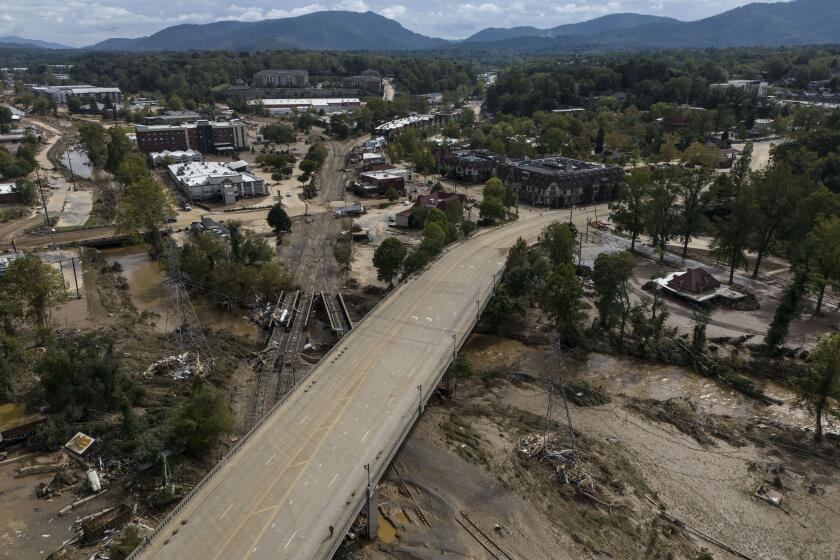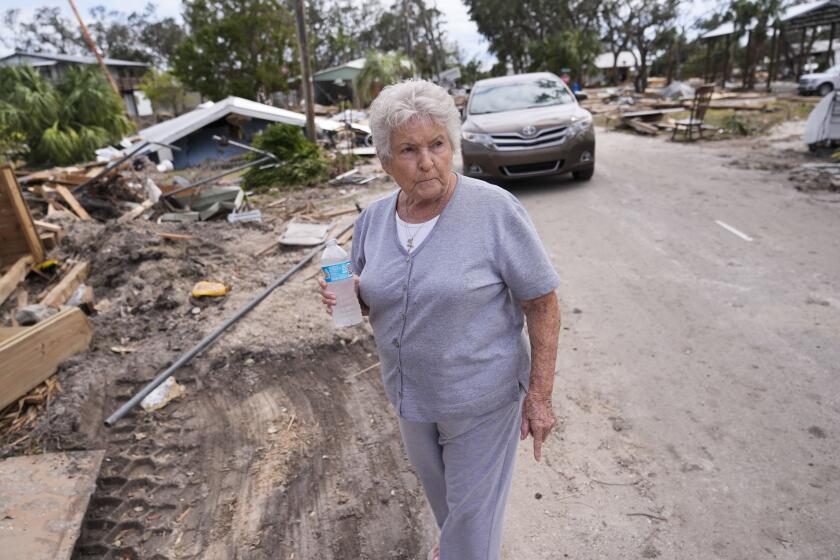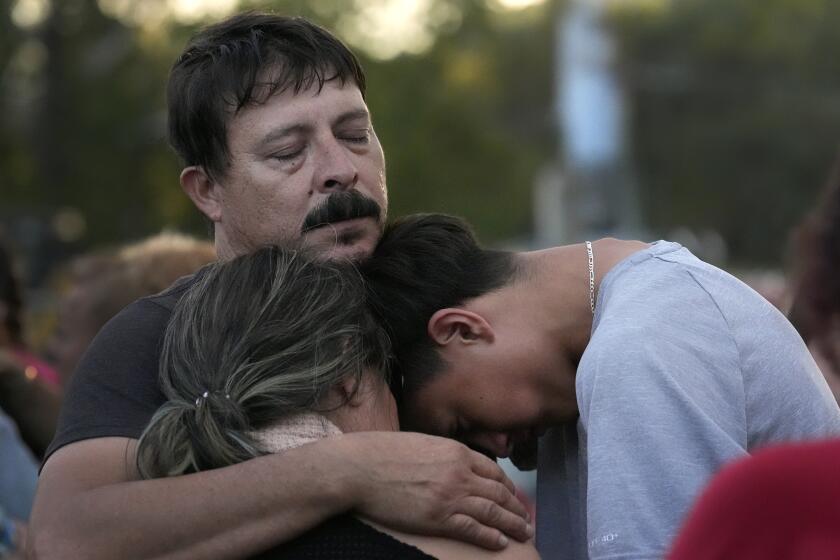Volunteers bring solar power to Hurricane Helene’s disaster zone

- Share via
BAKERSVILLE, N.C. — Nearly two weeks after Hurricane Helene downed power lines and washed out roads all over North Carolina’s mountains, the constant din of a gas-powered generator is getting to be too much for Bobby Renfro.
It’s difficult to hear the nurses, neighbors and volunteers flowing through the community resource hub he has set up in a former church for his neighbors in Tipton Hill, a crossroads in the Pisgah National Forest north of Asheville, N.C. Much worse is the cost: He spent $1,200 to buy it and thousands more on fuel that volunteers drive in from Tennessee.
Turning off their only power source isn’t an option. This generator runs a refrigerator holding insulin for neighbors with diabetes and powers the oxygen machines and nebulizers that some of them need to breathe.
The retired railroad worker worries that outsiders don’t understand how desperate they are, marooned without power on hilltops and down in “hollers.”
“We have no resources for nothing,” Renfro said. “It’s going to be a long ordeal.”
Hurricane Helene’s death toll topped 200 on Thursday and could rise higher still, as searchers make their way to places that are hardest to reach.
About 23,500 of the 1.5 million customers who lost power in western North Carolina still lacked electricity on Sunday, according to Poweroutage.us. Without it, they can’t keep medicines cold or power medical equipment or pump well water. They can’t recharge their phones or apply for federal disaster aid.
Crews from all over the country and even Canada are helping Duke Energy and local electric cooperatives with repairs, but it’s slow going in the dense mountain forests, where some roads and bridges are completely washed away.
“The crews aren’t doing what they typically do, which is a repair effort. They’re rebuilding from the ground up,” said Kristie Aldridge, vice president of communications at North Carolina Electric Cooperatives.
Residents who can get their hands on gas- and diesel-powered generators are depending on them, but that is not easy. Fuel is expensive and can be a long drive away. Generator fumes pollute and can be deadly. Small home generators are designed to run for hours or days, not weeks and months.
Now, more help is arriving. Renfro received a new power source this week, one that will be cleaner, quieter and free to operate. Volunteers with the nonprofit Footprint Project and a local solar installation company delivered a solar generator with six 245-watt solar panels, a 24-volt battery and an AC power inverter. The panels are resting on a grassy hill outside the community building.
As the death toll passed 150, searchers fanned out, using helicopters to get past washed-out bridges and hiking through wilderness to reach isolated homes.
Renfro hopes his community can draw some comfort and security, “seeing and knowing that they have a little electricity.”
The Footprint Project is scaling up its response to this disaster with sustainable mobile infrastructure. It has deployed dozens of larger solar microgrids, solar generators and machines that can pull water from the air to 33 sites so far, along with dozens of smaller portable batteries.
With donations from solar equipment and installation companies as well as equipment purchased through donated funds, the nonprofit is sourcing hundreds more small batteries and dozens of other larger systems — even industrial-scale solar generators known as Dragon Wings.
Will Heegaard and Jamie Swezey are the husband-and-wife team behind Project Footprint. Heegaard founded it in 2018 in New Orleans with a mission of reducing the greenhouse gas emissions of emergency responses. Helene’s destruction is so catastrophic, however, that Swezey said this work is more about supplementing generators than replacing them.
“I’ve never seen anything like this,” Swezey said as she stared at a whiteboard with scribbled lists of requests, volunteers and equipment. “It’s all hands on deck with whatever you can use to power whatever you need to power.”
Massive rains from powerful Helene left people stranded, without shelter and awaiting rescue around the U.S. Southeast.
Down near the interstate in Mars Hill, N.C., a warehouse owner let Swezey and Heegaard set up operations and sleep inside. They rise each morning triaging emails and texts from all over the region. Requests for equipment include individuals needing to power a home oxygen machine as well as makeshift clinics and community hubs distributing supplies.
Local volunteers help. Hayden Wilson and Henry Kovacs, glassblowers from Asheville, arrived in a pickup truck and trailer to make deliveries this week. Two installers from the Asheville-based solar company Sundance Power Systems followed in a van.
It took them more than an hour on winding roads to reach Bakersville, where the community hub that Julie Wiggins runs in her driveway supports about 30 nearby families. It took many of her neighbors days to reach her, cutting their way out through fallen trees. Some were so desperate that they stuck their insulin in the creek to keep it cold.
Panels and a battery from Footprint Project now power her small fridge, a water pump and a Starlink communications system she set up. “This is a game changer,” Wiggins said.
The storm, which claimed the lives of at least 227 people across six states, quickly overwhelmed Erwin, Tenn., an Appalachian town of around 6,000.
The volunteers then drove to Renfro’s hub in Tipton Hill before their last stop at a Bakersville church that has been running two generators. Other places are much harder to reach. Heegaard and Swezey even tried to figure out how many portable batteries a mule could carry up a mountain and have arranged for some to be lowered by helicopters.
They know the stakes are high after Heegaard volunteered in Puerto Rico, where Hurricane Maria’s death toll rose to 3,000 as some mountain communities went without power for 11 months. Duke Energy crews also restored infrastructure in Puerto Rico and are using tactics learned there, such as using helicopters to drop in new electric poles, utility spokesman Bill Norton said.
The hardest customers to help could be people whose homes and businesses are too damaged to connect, and they are why the Footprint Project will stay in the area for as long as it is needed, Swezey said.
“We know there are people who will need help long after the power comes back,” she said.
Angueira writes for the Associated Press.
More to Read
Sign up for Essential California
The most important California stories and recommendations in your inbox every morning.
You may occasionally receive promotional content from the Los Angeles Times.














